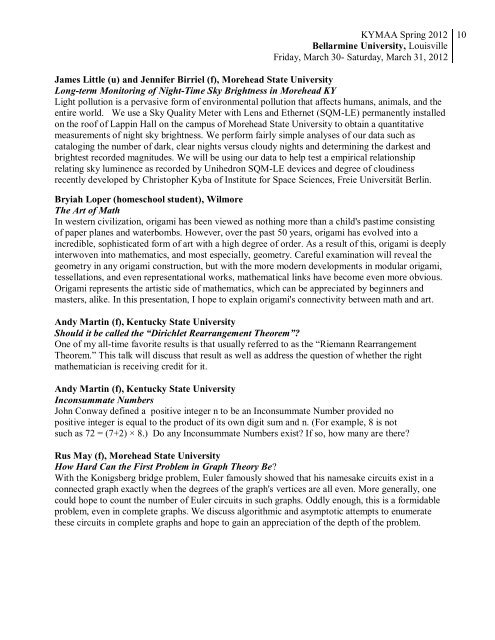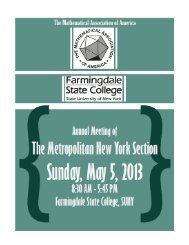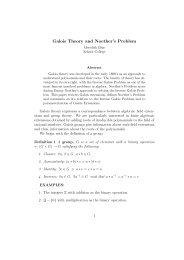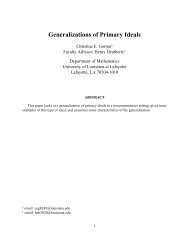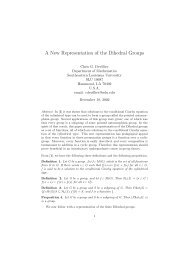Abstracts and Biographical Information - Sections - Mathematical ...
Abstracts and Biographical Information - Sections - Mathematical ...
Abstracts and Biographical Information - Sections - Mathematical ...
You also want an ePaper? Increase the reach of your titles
YUMPU automatically turns print PDFs into web optimized ePapers that Google loves.
KYMAA Spring 2012<br />
Bellarmine University, Louisville<br />
Friday, March 30- Saturday, March 31, 2012<br />
James Little (u) <strong>and</strong> Jennifer Birriel (f), Morehead State University<br />
Long-term Monitoring of Night-Time Sky Brightness in Morehead KY<br />
Light pollution is a pervasive form of environmental pollution that affects humans, animals, <strong>and</strong> the<br />
entire world. We use a Sky Quality Meter with Lens <strong>and</strong> Ethernet (SQM-LE) permanently installed<br />
on the roof of Lappin Hall on the campus of Morehead State University to obtain a quantitative<br />
measurements of night sky brightness. We perform fairly simple analyses of our data such as<br />
cataloging the number of dark, clear nights versus cloudy nights <strong>and</strong> determining the darkest <strong>and</strong><br />
brightest recorded magnitudes. We will be using our data to help test a empirical relationship<br />
relating sky luminence as recorded by Unihedron SQM-LE devices <strong>and</strong> degree of cloudiness<br />
recently developed by Christopher Kyba of Institute for Space Sciences, Freie Universität Berlin.<br />
Bryiah Loper (homeschool student), Wilmore<br />
The Art of Math<br />
In western civilization, origami has been viewed as nothing more than a child's pastime consisting<br />
of paper planes <strong>and</strong> waterbombs. However, over the past 50 years, origami has evolved into a<br />
incredible, sophisticated form of art with a high degree of order. As a result of this, origami is deeply<br />
interwoven into mathematics, <strong>and</strong> most especially, geometry. Careful examination will reveal the<br />
geometry in any origami construction, but with the more modern developments in modular origami,<br />
tessellations, <strong>and</strong> even representational works, mathematical links have become even more obvious.<br />
Origami represents the artistic side of mathematics, which can be appreciated by beginners <strong>and</strong><br />
masters, alike. In this presentation, I hope to explain origami's connectivity between math <strong>and</strong> art.<br />
Andy Martin (f), Kentucky State University<br />
Should it be called the “Dirichlet Rearrangement Theorem”?<br />
One of my all-time favorite results is that usually referred to as the “Riemann Rearrangement<br />
Theorem.” This talk will discuss that result as well as address the question of whether the right<br />
mathematician is receiving credit for it.<br />
Andy Martin (f), Kentucky State University<br />
Inconsummate Numbers<br />
John Conway defined a positive integer n to be an Inconsummate Number provided no<br />
positive integer is equal to the product of its own digit sum <strong>and</strong> n. (For example, 8 is not<br />
such as 72 = (7+2) × 8.) Do any Inconsummate Numbers exist? If so, how many are there?<br />
Rus May (f), Morehead State University<br />
How Hard Can the First Problem in Graph Theory Be?<br />
With the Konigsberg bridge problem, Euler famously showed that his namesake circuits exist in a<br />
connected graph exactly when the degrees of the graph's vertices are all even. More generally, one<br />
could hope to count the number of Euler circuits in such graphs. Oddly enough, this is a formidable<br />
problem, even in complete graphs. We discuss algorithmic <strong>and</strong> asymptotic attempts to enumerate<br />
these circuits in complete graphs <strong>and</strong> hope to gain an appreciation of the depth of the problem.<br />
10


